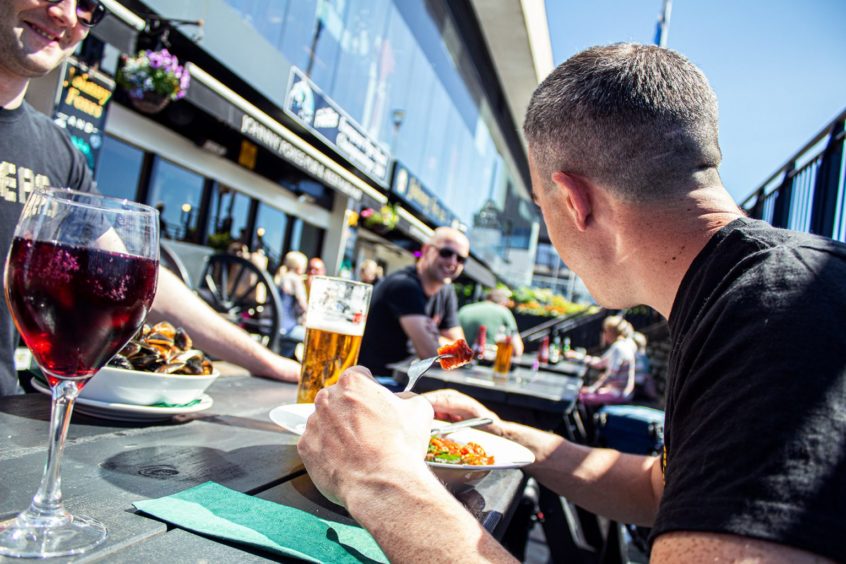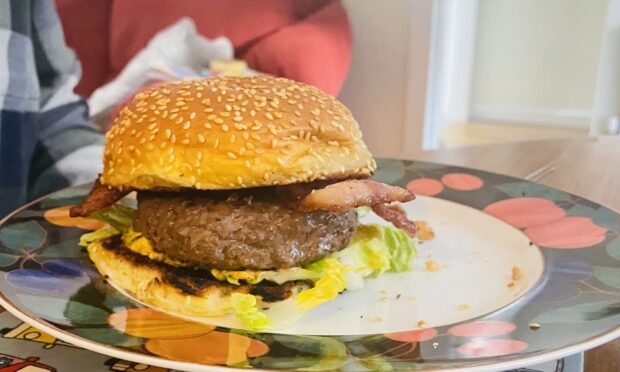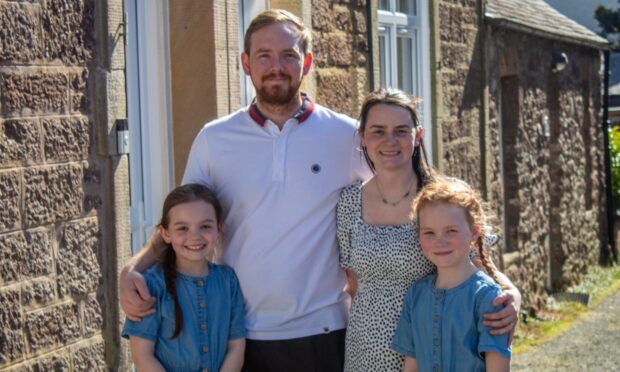With a decision to be made over whether the current two-metre distancing rule could be reduced, pubs stand to be among the biggest winners or losers depending on which way it goes.
The scientific advice is conflicting, yet for many of Scotland’s pubs the future may well depend on the final decree over the extent of social distancing when lockdown restrictions are further eased.
On Monday, the results of a major study were released which would have brought both hope and further angst to the industry. Hope, because it suggested the risk of catching coronavirus fell by 80% keeping just one metre apart; angst, because it also suggests reducing physical distancing in the UK from the current two metres to one metre could double the risk of infection. The research, part-funded by the World Health Organization (WHO), found the risk of infection is 1.3% at two metres, or 2.6% at one, prompting mixed interpretations of whether one metre would be enough.
Colin Wilkinson, managing director of the Scottish Licensed Trade Association (SLTA), said though social distancing measures of any kind post challenges for bars and pubs, a reduction would help.
He said: “Everyone wants to open up but it’s the practicality and viability. Currently the rule is two metres but that means capacity could be cut by up to 87% if it’s a standing pub. If it’s more food-led, capacity could be 60% and that still brings into question the viability. The measures you have to put in place are going to be onerous.
“The Prime Minister has said they’re looking at the two-metre rule, and the Scottish Government are aware and are looking at it too. WHO’s recommendation is one metre. In France they’re reopening at one metre distance and that would certainly be better.
“I saw some figures saying 37% of businesses thought that would make the difference, but the others were either unsure or thought it didn’t. For people who can operate we would certainly encourage them to do it, that’s obvious, but they also have to look at the complexities and the viability. Why open if it’s just going to be more expensive?”

And the complexities are manifold for landlords and pub owners. Last week, First Minister Nicola Sturgeon announced a four-stage strategy to bring Scotland out of lockdown. Under phase one the restrictions around our personal movements have eased slightly, but it will not be until “phase two” that pints will be served again – and only in outdoor spaces with physical distancing and increased hygiene measures in place. Under “phase three” bars will be able to fully open but likely with strict social distancing rules remaining.
Now those businesses that either have or may be able to apply for a licence to operate outdoors are weighing up the costs and viability of doing so.
“It’s not just the distancing,” said Colin Wilkinson. “You’ve got issues with costs too. If you apply for an outdoor licence it’s £132 per square metre on George Street in Edinburgh, for instance.
“The issue is whatever area you have cordoned off or wherever you put your barrier [customers] would have to be two metres back because you’ll have members of the public walking past. So you can see the issues.”
Local businessman Jimmy Marr, who owns several pubs and restaurants in Dundee, says the extent of the distancing could be the difference between reopening or not.
He said: “For small pubs, we have the Taybridge Bar on Perth Road, and Harlequins on Albert Street, and the two-metre rule would be practically impossible to work there. But we’ve also got 172 at The Caird on Perth Road with plenty of indoor space and a beer garden, and Nicolls on Commercial Street, and it could work there.
“If it was reduced to a metre it would be a great benefit but it’s got to be about safety. It’s all a big unknown and we still don’t know when we’re going to get to open.
“Now [the UK Government] is saying in two or three months they’ll stop the furlough scheme and we have to pay our staff, but how can we if our pubs and restaurants are closed? I think they need to look at the leisure industry separately. They’re forcing us to stay closed – for good reason – so we’re going to need more help.”
For now, Jimmy is preparing the beer garden at 172 at The Caird for when phase 2 is announced, but he has concerns for the smaller pubs.
He said: “We’re spacing tables out in the beer garden. I’ve heard that maybe from the 17th of June outside beer gardens might open so we’re waiting to hear from the council. We’ve got hand sanitisers and a system for using the toilets inside – staff would let one person in at a time – but the rest of the building will be shut.
“Smaller community pubs couldn’t survive, and we couldn’t bring staff back at a two-metre distance. One metre compared to two would be a big help. We looked at Taybridge and if it was one metre we could have people at every second table, and they wouldn’t come to the bar but we would have table service. You could bring back some but not all of your staff and open on reduced hours.”
David Reekie, who runs Kinnears Inn in Scone, recently announced the closure of his business, citing social distancing as a stumbling block.
He added: “When the pubs do open back up people will be chomping at the bit for a pint but we’re that small anyway that we couldn’t put in social distancing.
“Places are going to be chock-a-block. Our bar restaurant can sit 40. If we need to social distance we’re going to be half of that and then you’re asking yourself is this is viable. The figures are just not adding up at all.”
For the shorter-term, some pubs are looking at expanding into their car parks, with officials at Aberdeen City Council inviting businesses to get in touch to apply for additional outdoor seating.
Councillor Marie Boulton said last week: “Some businesses have outdoor areas and there will be those trying to open some that will require people to put in occasional licenses.
“Certainly we recognise businesses’ needs at the moment, and we’ll be working very closely to facilitate what we can, but we need to be mindful there are people on the streets, and there are those businesses that are in heavily residential areas.
“We’d encourage people if they would be interested in going down that avenue to put an application in as soon as possible if they want outdoor seating or to use their car parks. We’re ready to action any requests we get.”
But, Colin Wilkinson of the SLTA warns, outdoor trading is not a magic wand for the industry and may only be viable for a few rather than the many.
He added: “We don’t see this opening of outdoor areas as the great thing to save the industry. It’s alright having outdoor areas, but with the good old Scottish weather you could put something together outside and the heavens open. We’re hearing members talking about having some kind of marquee set up, but that’s not an outdoor area. So until we see protocols and how we are going to operate, it’s really very difficult to tell.”
In Inverness, Don Lawson, owner of Johnny Foxes bar and restaurant in the city centre, said he had initially decided not to open at all while social distancing measures were in place, but changed his mind because of the opportunity to bring some staff back. He will now reopen the business to customers on July 1, with table service outdoors.
He said: “We’re only opening the outside patio area where I can get about 30 people sat [with social distancing] as opposed to 80 or 90. If I broke even I’d be happy. I need to get some of the staff off furlough and get them trained and ready for August/September.
“Up until a week ago I wasn’t going to open at all until social distancing was in the history books but I’ve changed my mind simply because doing it this way gives me a run-in, a soft opening if you like, because usually, with outdoor and indoor seating, we can take 520.
“I know there’s a lot of lobbying going on at the moment to curtail the distancing to one metre, or even 1.5m would make a lot of difference to pubs, including ourselves. Pubs are on a life support machine and the longer they remain on it the more likely it is some will not survive. Once they close it will be hard to resuscitate them.”
Today, Marc Crothall, chief executive of the Scottish Tourism Alliance (STA), wrote to the Scottish Government to formally request a reduction in social distancing parameters to protect the leisure industry.
He said: “Perhaps the most important issue which will affect the viability of the majority of Scotland’s tourism businesses is the two-metre rule for social distancing. We would ask that the Scottish Government carefully evaluate and give every due consideration to agreeing to the one-metre parameter for distancing which is considered by the WHO to be a safe distance.
“The STA has had numerous discussions with tourism businesses and sectoral associations over the past few weeks to discuss the likelihood of many types of businesses being able to open and trade viably if the two-metre rule was to be extended through the different phases of reopening.
“The reality as I’m sure you know is that the majority believe that it will not be economically viable to do so at two metres and, as a result, would have to close until such time as there was a change to the distancing measures. Many may not be able to hold out until then and the difference could mean many tens of thousands of jobs being saved or lost.”














